
We have had a few cool nights recently, which is just wonderful since I can sleep with the windows open — at least when the smoke from Canada blows away! I cannot remember the last time we had a real spring like we are experiencing this year, with plenty of gentle rain. This beneficial rain is wonderful for all the spring plant growth and such a pleasure.
I am so in awe of the miracle of Mother Nature; the symbiotic relationship between plants and all of God’s creatures. As I looked out of the window from my old home a few years ago, I could see the buds opening on my long border of Peonies, which had been planted by the original homeowner in the early 1900s. As I looked, I was reminded of the special relationship between ants and peonies.
A question often asked of me is “Maureen, should I worry about ants on my peonies?”
My answer, “That’s not a problem, lots of ants on the peonies just demonstrate that you have healthy plants with big buds producing bountiful nectar, which attracts the ants”. By the way, ants are very useful creatures; their presence indicates that there are aphids and whiteflies in the area and ants feed on these troublesome insects.
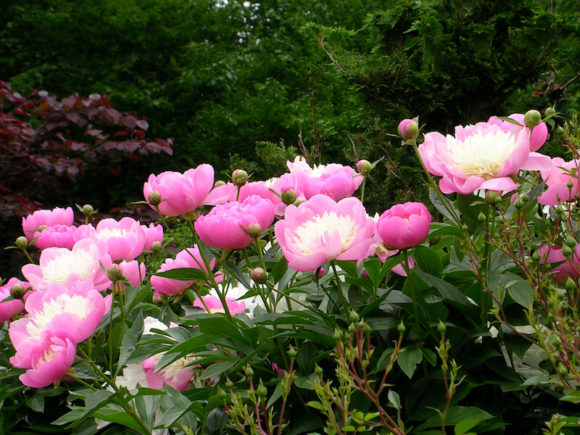
Please ensure that Peonies get plenty of water and check the pH of the soil, which should register between 6.5 and 7.0. In early June, I pinched off the side buds on the peonies, as by doing this, it ensures big terminal blooms on the plant. When the bloom has past, apply a light application of composted manure to encourage the soil animals and the manure bacteria to keep the soil healthy.
Do not cut the peonies down to about six inches until after the first frost in November. In September, plant or transplant Peonies and in the process barely cover the pink eyes on the roots with soil, just enough so the plant does not fall over.
Beginning in spring, many insect pests appear in the garden; a useful creature against the pests is the lowly toad. I suggest putting some toad houses in and around your borders. You can purchase toad houses from the garden center if you wish. Or you can do as I do, which is to use an old clay pot that is cracked and make sure that the crack is two to four inches wide for a door so the toad can enter. Also put a small saucer as a floor under the pot with some rocks, and keep the rocks damp, so that your friendly bad-bug eater has his or her ideal home environment and will snack on hundreds of pesky bugs.
MULCH:
Mulch your gardens this month when the ground has warmed up to 55 degrees. When mulching, be careful mulching around trees. Apply the mulch at least six inches from the base of the trunk — any closer can cause rot and disease in the bark and roots of the tree. Also, trees that are mulched too close to the trunk invite mice and other rodents to come nest and gnaw on the trunk. Your garden can be mulched to a depth of between two and three inches and I use natural fine dark brown hardwood mulch. Please do not use dyed red mulch, which is poisonous. Keep your garden natural, herbicide and pesticide free.
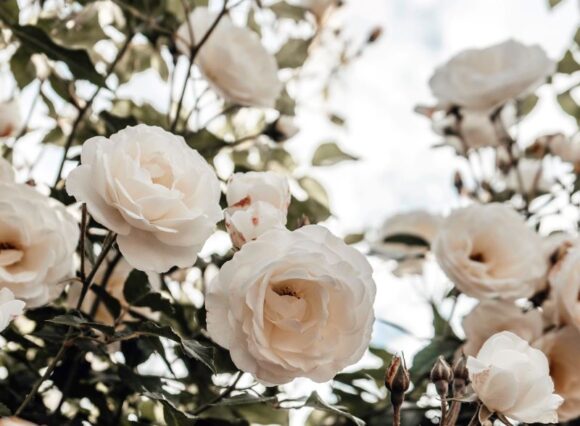
June is the month when Roses begin to bloom. I prefer to use David Austin roses in my garden and in my designs. I find that David Austin roses are the most-trouble free Roses and offer great rewards, being repeat bloomers with wonderful fragrances and colors.
Some of my favorite David Austin roses are:
‘A Shropshire Lad’, a soft peachy pink.
‘Abraham Darby’ with blooms producing petals that are a blend of apricot and yellow.
‘Fair Bianca’ a pure white.
‘Heritage’ a soft clear pink.
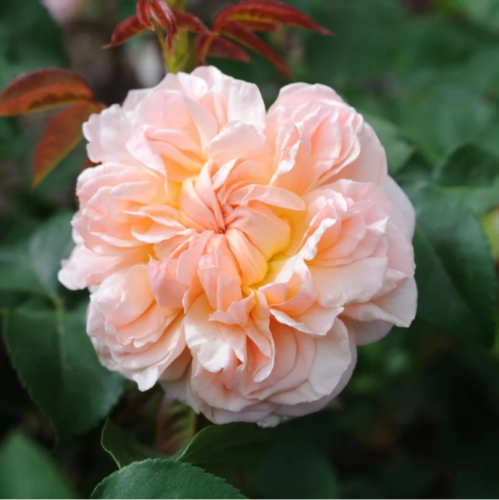
And my absolute favorite is ‘Evelyn’. Evelyn has a large apricot saucer shaped bloom with a fragrance that is second to none offering a luscious, fruity tone that reminds me of fresh peaches and apricots.
Feed your roses with composted manure, keeping the manure and mulch about six inches away from the base of the rose and adding a few more inches of manure once a month until mid- August. At that time stop feeding so the roses can gently move into a much-needed slow dormancy. You do not need any other Rose food except the manure and, of course, the mulch, which attracts carbon from the atmosphere to produce the humus component.
Japanese Beetles are attracted to roses, therefore; Japanese Beetle traps should be placed far away from your borders on the perimeter of the property.
A tip for keeping cut roses fresh: cut the roses in the early morning, cutting just above a five-leaf cluster and place stems in a container of lukewarm water. Inside the house, recut the stems at a one and half inch angular cut, under warm running water, then place cut roses in a vase filled with warm water. Do not remove the thorns on cut roses, removing the thorns reduces their indoor life by as much as three days.
Hydrangeas: need plenty of water. In the fields, where they were originally discovered, were wetland areas. Then, fortunately for us, some gardeners introduced them into their gardens and ‘the rest is history’. Apply aged manure around the Hydrangeas, which should be planted in full sun and spaced at least four feet apart for good ventilation and to prevent mildew from occurring. If you have blue Hydrangea macrophylla and want a more vibrant shade of blue, add some peat moss on top of the manure. The acidity in the peat will produce a lovely deep shade of blue.
Wisteria: regular pruning through spring and summer is the main factor to help this arrogant vine to flower. Prune several times during the growing season, which means pruning every two weeks by at least six inches on each stem.
Clematis wilt: if you have this problem with clematis, you will notice it early because the shoots wilt and die. This disease is impossible to cure, as it is soil-borne. Soil-borne means that it is not possible to plant another clematis of that species in that area of the garden. However, you can plant the Viticella clematis variety. The Viticella clematis are vigorous, free-flowering blooms and are not susceptible to wilt. Some good choices of this variety are Blue Belle and Etoile Violette — both are purple — and Huldine, which is white,
CONTAINER GARDENS:
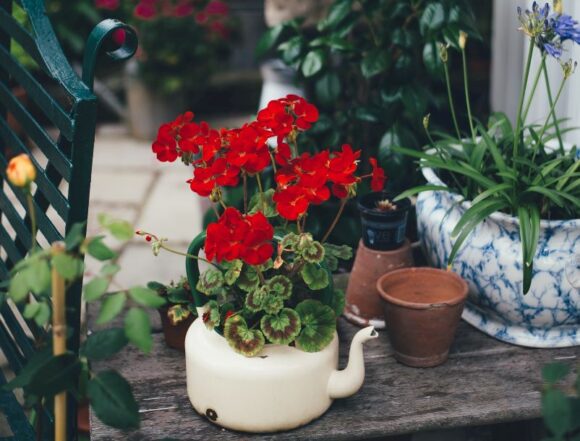
If you have room for one pot, you have room for a number! By placing them close together with different shapes and sizes, you can create your own miniature garden. Apart from regular pots, the most unexpected objects make interesting containers. A friend who cut down trees this past winter, left the stumps and hollowed them out to make containers, one large and two smaller stumps together, and it made an interesting combo.
Check in your basement, shed or barn to see if you have an old wheelbarrow, even if the wheelbarrow has a wheel missing like mine, which I painted with eco-conscious paint and then placed near the kitchen door filled with bright colored vines, miniature grasses and small perennials.
Or you may discover a large old ceramic jar, which is what happened to me when I came across an old two-foot-tall ceramic vinegar container in the barn, replete with a hole where the vinegar tap was inserted, making it ideal for drainage. The jar planted with multi-colored perennials looked great on my newly-painted, blue bench beside my red milk shed.
LAWN CARE:
Do not forget to add organic grub control through July, so that you help to keep down the mole infestation; remember no grubs, less food for the moles.
POWDERY MILDEW:
Keep an eye open for powdery mildew, especially after a rain when humidity returns. My recipe for powdery mildew is as follows:
In a sprayer, mix two tablespoons of baking soda, one tablespoon of vegetable or horticultural oil in a gallon of water and spray the mildew. Hydrangeas and Summer phlox are particularly prone to this problem. To held counteract the mildew problem, I recommend Phlox Miss Lingard or Phlox David, which are the white Phlox and are the most mildew resistant.
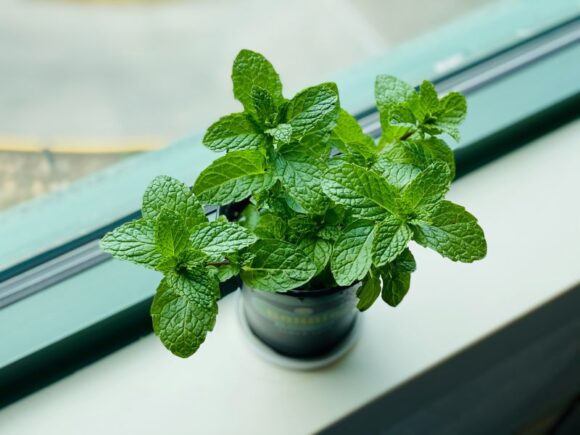
Monarda, commonly known as Bee Balm, are also affected by mildew and the one I have found to be the most resistant is “Cambridge Scarlet”. However, please be careful when introducing Monarda into the garden; this plant, like Purple Loosestrife and Evening Primrose are extremely invasive and can take over your entire border.
Regarding invasive plants; if you plant mint, plant it only in containers, otherwise that too will wildly spread throughout your borders.
I hope these tips are useful to you during this busy time of year in the garden. Stretch, hydrate and enjoy the burgeoning promise of your garden and I’ll see you next month.
If you would like some more gardening advice, contact my son Ian at LandscapesByIan.com. I am sure you would enjoy speaking with him as he is full of knowledge and, as the old saying goes, “The apple does not fall far from the tree!”
About the author: Maureen Haseley-Jones is a member of a family of renowned horticultural artisans, whose landscaping heritage dates back to the 17th century. She is one of the founders, together with her son Ian, of, The English Lady Landscape and Home Company. Maureen and Ian are landscape designers and garden experts, who believe that everyone deserves to live in an eco-conscious environment and enjoy the pleasure that it brings. Maureen learned her design skills from both her mother and grandmother, and honed her horticultural and construction skills while working in the family nursery and landscape business in the U.K. Her formal horticultural training was undertaken at the Royal Botanic Gardens at Kew in Surrey.